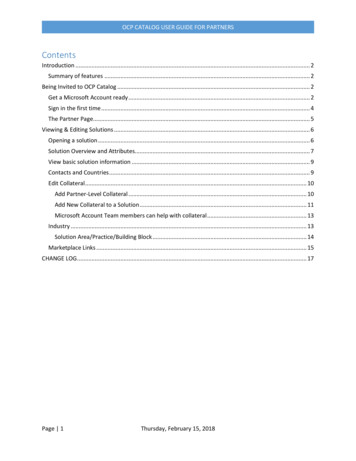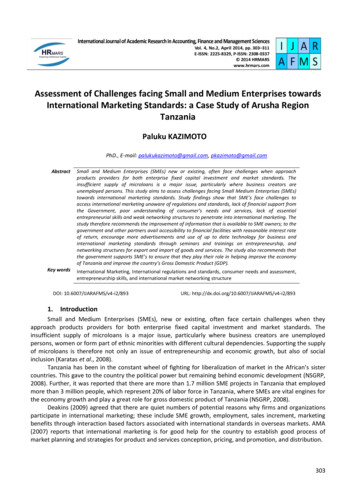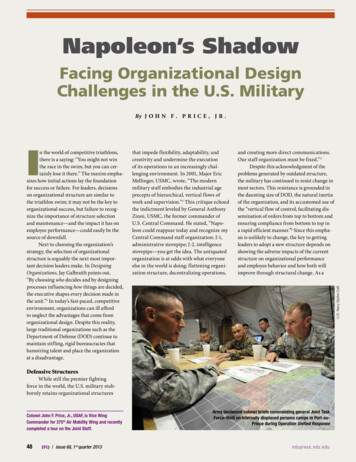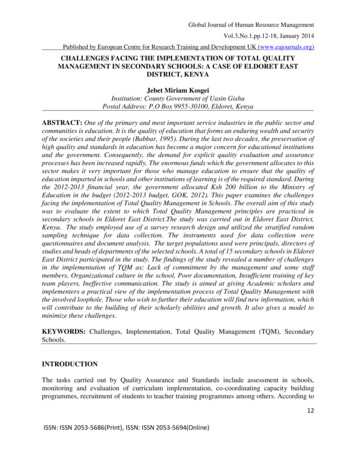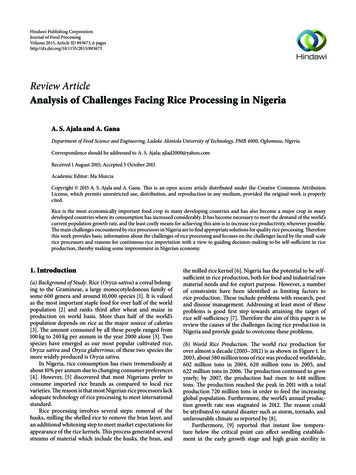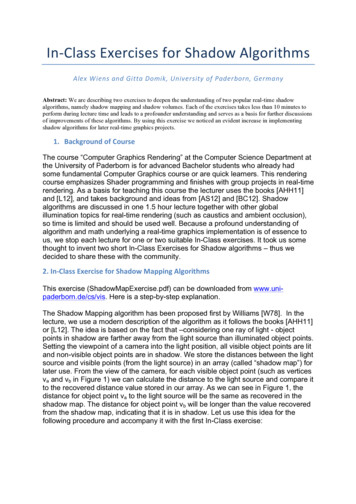
Transcription
Challenges and Opportunities Facingthe North Carolina Health WorkforceErin Fraher PhD MPP, DirectorWith Julie Spero, MSPH; Tom Ricketts, PhD, MPH;Evan Galloway, MPS; and Katie Gaul MAProgram on Health Workforce Research and PolicyHealth Deans Meeting, UNC System OfficeMarch 2, 2018
Key Takeaways Sheps Center houses health workforce data and expertisethat are invaluable to UNC system and state policy makers Allied health workforce studies were funded in past by theDuke Endowment and Council for Allied Health State is facing significant health workforce challenges thatUNC system’s health programs are well positioned to address Efforts to address workforce challenges are congruent withUNC System goals to increase access, affordability, studentsuccess and economic impact
Health workforce trends Health care jobs generally will continue to grow rapidly Supply has increased but workforce remains persistentlymaldistributed Racial/ethnic diversity of workforce does not match population Changing care delivery and payment models are:– shifting care and workforce from inpatient to community settings– generating new professions and roles Career ladders are needed
Past allied health workforce studies:fundingMultiple sources supported Sheps allied health workforce analyses;total direct support approximately 440K from over 11 years (2001-12)The Duke Endowment via NC AHEC, CAHNC, 2001-2007 Supported 3 profession-specific reports (rad sci, respiratory therapy,clinical lab sci), 1 state of allied health brief, 3 AH job vacancy tracking reportsNC Hospital Association, 2007-2008 Produced “North Carolina Hospital Workforce Trend Analysis, 2004-2006”HRSA via NC Commerce, 2010-2012 State health workforce planning grant helped support 1 state of allied healthbrief, 3 AH job vacancy tracking reports*CAHNC Council for Allied Health in North Carolina
Past allied health workforce studies:productsIn collaboration with AHEC and the CAHNC from 1999-2012, produced in-depthprofession reports, shorter profession briefs, state of allied health fact sheets,allied health job vacancy tracking reports; also gave many, many 00520112012
Strong history of producing workforce studiesto support UNC System program planningRecently conducted studies for UNC System (2017-18) Potential health sciences school at UNC-PFeasibility of physician assistant program at WSSUFeasibility of chiropractic medicine program at WSSUEvaluating outcomes of NC medical training programsOlder studies for UNC System – data to support decisions about New optometry program in NC (2015)Pharmacy workforce in NC – updated report (2014)New school of pharmacy at UNC-G and UNC-CH (2010)New dental school at ECU (2007)Older studies for NC Community College System A Study of Associate Degree Nursing Program Success (2008)
We house longitudinal data on variety oflicensed health professions Physicians (MDs and DOs) Registered Nurses Physician Assistants Nurse Practitioners Dentists Certified Nurse Midwives (1985) Dental Hygienists Licensed Practical Nurses Optometrists Chiropractors Pharmacists Podiatrists Physical Therapists Psychologists Physical Therapist Assistants Psychological Associates Respiratory Therapists (2004) Occupational Therapists (2006) Occupational Therapy Assistants (2006)
NC has some of best workforce data innation for workforce studiesData elements that usually don’t change Name Date and place of birth Race/ethnicity Gender Basic professional degree (degree conferred, name and location ofinstitution attended, practice qualifications) Unique identifier
NC has some of best workforce data innation for workforce studiesData elements that may change andare updated annually: Employment address Home address Type of position Employment setting Clinical practice area Activity status (retired, active practice, not employed in profession) Average hours per week/employment status Highest degree Foreign language ability (for select professions)
In May 2017, converted Data Book to online,interactive data visualization tool Explore 15 years of data on overa dozen health professions in NC Total supply, supply per 10K,percent female, percent over 65,percent minority State and county-level data Interactive map and bar charts Can download data for use inpresentations or for analysis nchealthworkforce.sirs.unc.edu
Health care jobs will continueto grow rapidly
In 2009, health care jobs surpassedmanufacturing jobs800Total Employment in Manufacturing and Health Care andSocial Assistance Employment in NC, 2000-2016748.7Employment (1000s)700600Health Care and Social 00YearSource: North Carolina Health Professions Data System with data derived from the North Carolina Department of Commerce Labor and Economic Analysis Division, Current EmploymentStatistics (CES), 2000-2016. Data include unadjusted employment as of October of the given year. Downloaded on April 12, 2017 from: d By: Program on Health Workforce Research & Policy, Cecil G. Sheps Center for Health Services Research, University of North Carolina at Chapel Hill.
Two of every three health care jobsis in allied health or nursingHealth Care Jobs in North Carolina, 2016Other Doctoral Trained* 4%Physicians 5%APRNs 2%Allied Health 36%RNs 24%n 406,490Health Care JobsLPNs 4%*Note: Other Doctoral Trained includes chiropractors,dentists, optometrists, pharmacists, & podiatrists.Source: Data derived from US Bureau of Labor Statistics, OccupationalEmployment Statistics, State Cross-Industry Estimates: 2000-2016.URL: http://www.bls.gov/oes/oes dl.html. Accessed 12 April 2017Aides and Attendants 25%
Nursing and allied health jobshave grown rapidly90%Percent Growth Since 2000, Health Care Fields vs. All Occupations,North Carolina, 2000-201683% Allied Health74% RNs70% Total HealthcareEmployment63% Aides, Orderliesand Attendants80%Percent Growth70%60%50%40%30%20%10%10%0%-10%YearSource: North Carolina Health Professions Data System with Data derived from US Bureau of Labor Statistics,Occupational Employment Statistics, State Cross-Industry Estimates: 2000-2016. URL: http://www.bls.gov/oes/oes dl.html. Accessed 12 April 2017.Produced By: Program on Health Workforce Research & Policy, Cecil G. Sheps Center for Health Services Research, University of North Carolina at Chapel Hill.Total NCEmployment,All Occupations
Supply has grown butworkforce remainspersistently maldistributed
Rural areas have fewer professionals. Assistantsgenerally better distributed than therapistsRural (nonmetropolitan) county
Rural areas have fewer professionals. Assistantsgenerally better distributed than therapistsRural (nonmetropolitan) county
Racial/ethnic diversity ofworkforce does not matchNC’s population
Diversity of workforce has improvedbut still laggingDiversity of NC Population versus Select Health ProfessionsNorth Carolina, 201440%Other/Multiracial1.6%2.7%30%Asian/Pacific IslanderHispanicAmerican Indian/Alaskan 1.3%2.0%22%6.2%12%0%2.3%NC DIVERSITY %10%Physical TherapistsOccupationalTherapy 1.5%2.5%2.7%0.8%5%1.4%1.0%1.1%0.6%8%Physician Assistants Physical TherapistAssistantsSources: North Carolina Health Professions Data System with data derived from North Carolina licensing boards, 2014. Figures include active, instate, dentists, nurses,pharmacists, PTs, OTs and optometrists and active, instate non-federal, non-resident-in-training physicians licensed as of October 31 of the respective year.Produced by: Program on Health Workforce Research and Policy, Cecil G. Sheps Center for Health Services Research, University of North Carolina at Chapel Hill.
Increased efforts needed to recruit Hispanic,African-American and Native Americanstudents into health professions African-American population has remained stable ( 22% ofpopulation) over past 25 years. Yet blacks are dramaticallyunderrepresented in workforce, ranging from 2.5% ofoptometrist workforce to 12.5% of respiratory therapy workforce NC’s Hispanic population increased from 1.2% in 1990 to 9% ofpop in 2014. Hispanics make up 2.9% of physicians, 2.7% ofphysician assistants and 1.8% of dentists Native American population also underrepresented in healthworkforce but there are some success stories
2% of Respiratory Therapists are American Indian.58% of them were trained atRobeson Community College.Race of Respiratory Therapists inNorth Carolina, 2016HispanicOther, 1%Asian/Pacific Islander, 2% 1%Missing, 2%American Indian, 2%White, 79%Black13%n 4,203American Indian Respiratory TherapistsPracticing in North Carolina, 2016Robeson CommunityCollege, 58%Other NC Schools, 15%Outside NC, 7%FayettevilleTechnicalCommunityCollege, 8%n 88SandhillsCommunityCollege, 12%Sources: North Carolina Health Professions Data System with data derived from North Carolina Respiratory Care Board, 2016. Figures include active, instate respiratory therapists licensed as ofOctober 31, 2016. Produced by: Program on Health Workforce Research and Policy, Cecil G. Sheps Center for Health Services Research, University of North Carolina at Chapel Hill.
HBCUs making important contribution toBSN-prepared nursing workforceRegistered Nurses by Race/Ethnicity and Highest Degree,North Carolina, 7%54%White(65,047)42%52%36%64%58%33%67%48%Black (8,931)AI/Alaska(749)Hispanic(1,005)BSN (44,707)Asian (2,193)Hawaiian Other (1,058)Pac/Islndr (36)ADN (34,312)Sources: NC Health Professions Data System with data derived from the NC Board of Nursing, 2015. Note: Figures include active, instate registered nurses licensed as of October 31 of therespective year. Data exclude 7,567 RNs whose highest degree is outside of nursing and 5,792 RNs whose highest degree is a diploma. 233 RNs were missing race data and 7,523 were missingdata on highest degree. Produced by: Program on Health Workforce Research and Policy, Cecil G. Sheps Center for Health Services Research, University of North Carolina at Chapel Hill.
Moving from NC to thenation .
We are one of seven federally funded HealthWorkforce Research CentersThe Sheps Center houses the Carolina Health Workforce Research CenterCenter’s Mission: conduct and disseminate timely and policy-relevant researchthat enables policy makers to swiftly respond to the challenge to train, retrain,deploy and retain a highly skilled, culturally competent, diverse and high valuehealth workforce.Director:Erin Fraher, PhD, MPPDeputy Director:Thomas Ricketts, PhD, MPHInvestigators:Multi-disciplinary group of researchers representinghealth policy, medicine, nursing, public health, social work;allied health and other professionsFunding:From the Bureau of Health Workforce, Health Resourcesand Services Administration, 4.3 million, plus one-timesupplements; 2013-2022
Relevant HWRC projects –allied health and social work Use of Physical and Occupational Therapists in the Acute Care toCommunity Transition Following Stroke– Describe factors associated with use of PTs & OTs following stroke and the extentto which PT/OT use decreased rehospitalization. Integration of Rehabilitation Care from the Acute to CommunitySetting: The Role of Physician Referral– Describe ambulatory care physicians’ referrals to PT over time and bycharacteristics; identify physician- and patient-level predictors of referral Toward a Better Understanding of Social Work Roles and Functionson Integrated Care Delivery Teams– Understanding the roles of social workers in PCMHs and the barriers/facilitatorsto deploying social workers on interprofessional research-center/25CAROLINA HEALTH WORKFORCE RESEARCH CENTERwww.healthworkforce.unc.edu
Other federal workforce efforts University of Washington Center working on allied healthhttps://depts.washington.edu/fammed/chws/ National Center for Health Workforce Analysis is conductinghealth workforce projections in allied health includingdieticians, dental hygienists, therapy professions and is/research/projections26CAROLINA HEALTH WORKFORCE RESEARCH CENTERwww.healthworkforce.unc.edu
Looking ahead:workforce roles andemployment settings are changing
Workforce is shifting fromacute to community settings Changes in payment policy and health system organizationhave resulted in:– Shift from fee-for-service toward risk- and value-based models– Fines that penalize hospitals for readmissions Will increasingly shift health care — and the health careworkforce — from expensive inpatient settings toambulatory, community and home-based settings But we generally educate health workers in inpatient settings Current workforce not adequately prepared to work inambulatory settings and patients’ homes
Fastest job growth has been in ambulatorycare and home healthHospitalsNursing Homes& ResidentialCarePhysicianOfficesSource: e Health
Increased focus on population health requiresbroader definition of the health workforcePopulation health requires us to: Expand workforce planning efforts to include workersin community and home-based settings Embrace the role of social workers, patient navigators,community health workers, home health workers, communityparamedics, dieticians and other community-based workers Plan for workforce needs of patients and communities,not for needs of professions Determine how to integrate the public health workforce intohealth workforce planning
And new health care teams are emerging:Community Aging in Place—Advancing BetterLiving for Elders (CAPABLE) Teams An Occupational Therapist, a Registered Nurse, and a handymanform team allowing seniors to age in homes Provide assistive devices and make home modifications to enableparticipants to navigate their homes more easily and safely After completing five-month program, 75 percent of participants(n 281 adults age 65 ) had improved their performance of ADLs Symptoms of depression and ability to perform instrumentalADLs such as shopping and managing medications also improved Health systems are testing CAPABLE on a larger scalehttp://nursing.jhu.edu/faculty research/research/projects/capable/Source: Szanton SL, Leff B, Wolff JL, Robers K, Gitlin LN. (2016). Home-Based Care Program Reduces Disability And Promotes Aging In Place. Health Affairs; Sep 1;35(9):1558-63.
Social workers play increasingly importantboundary spanning rolesSocial workers serving three functions on integratedbehavioral health/physical health teams: Behavioral health specialists: provide interventions forpatients with mental health, substance abuse and otherbehavioral health disorders Care managers: coordinate care of patients with chronicconditions, monitor care plans, assess treatment progress andconsult with primary care physicians Referral role: connect patients to community resourcesincluding housing, transportation, food, etc.Fraser M, Lombardi B, Wu S, Zerden L, Richman E, Fraher E. Social Work in Integrated Primary Care: A Systematic Review. Carolina Health Workforce Research Center, Program on HealthWorkforce Research and Policy, Sheps Center for Health Services Research. September 2016. 2016/12/PolicyBrief Fraser y3 final.pdf.
Developing the workforce tomeet the health and educationneeds of NC’s population
We need to better connecteducation to practice “Revolutionary changes in the nature and formof health care delivery are reverberating backwardinto education as leaders of the new practice organizationsdemand that the educational mission be responsive to theirneeds for practitioners who can work with teams in moreflexible and changing organizations ” But education system is lagging because it remains largelyinsulated from care delivery reform Need closer linkages between health care delivery andeducation systemsSource: Ricketts T, Fraher E. Reconfiguring health workforce policy so that education, training, and actual delivery of care are closely connected. Health Aff (Millwood). 2013 Nov;32(11):1874-80.
and redesign educationto support new roles Retrain and upgrade skills of the 500,000 health careworkers already practice in NC– they are the ones who willtransform care Training must be convenient – timing, location, andfinancial incentives must be taken into consideration Need to prepare faculty to teach new roles and functions Clinical rotations need to include “purposeful exposure” tohigh-performing teams in ambulatory settings Need to redesign education system so workforce can flexiblygain new skills and competencies throughout career
Need “model” teaching sites inrural communities We need rural teaching health centers (like Roanoke-Amaranth),rural teaching hospitals and rural teaching long-term care facilities toprepare a rural workforce that is innovative and focused on qualityand population health. Model teaching sites would also createexciting work places that will keep students in rural communitiesafter graduation. We need to:– Create more community-based rotations for health professionalstudents– Support truly integrated models of behavioral health andprimary care. Put particular focus on integrating social workersinto primary care settings
Need to foster strongeracademic-practice partnerships Employers need to work with educational institutions todevelop modular courses for currently employed workers topromote a more flexible workforce with skills needed in atransformed health system The alternative might be unemployment if, for example,nurses are not able to make the transition from inpatient tooutpatient facilities as the jobs move there Need more training in new roles such as patient navigation,care coordination, informatics, and patient coaching
Support increased access to healthprofessions jobs for rural students andunderrepresented minorities Access to health care in rural communities is important but so isaccess to employment in health care Support efforts to increase diversity in nursing and allied health andfund efforts that get more African American men into medicine anddentistry Expand definition of diversity to include socio-economic status.Consider ways to get more students from Tier 1 counties intomedical school, nursing etc. Work with community college system to develop career ladders
We can help you get there:Sheps tools and resources Data Ability to translate data into robust, policy-relevantgraphs, maps, charts etc. Visualizations Workforce modeling capability Connections to educators, regulators, professional associations Neutral player Nationally recognized expertise
Contact infoErin Frahererin fraher@unc.edu(919) 966-5012Program on Health Workforce Research and Policyhttp://www.healthworkforce.unc.edu
Two of every three health care jobs is in allied health or nursing Other Doctoral Trained* 4% Physicians 5%. APRNs 2%. RNs 24%. LPNs 4%. Aides and Attendants 25%. Allied Health 36%. Health Care Jobs in North Carolina, 2016 *Note: Other Doctoral Trained includes chiropractors, dentists, optometrists, pharmacists, & podiatrists. n 406,490 Health .



